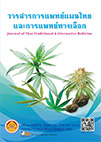Situation of Herbal Solution Consumption and Factors Associated with Steroid-Adulterated Herbal Solutions in Ang Thong Province N/A
Main Article Content
Abstract
Rationale and Objective: This cross-sectional analytical study aimed to investigate the situation of herbal solutions consumption and factors related to steroid adulteration in herbal drinks in Ang Thong province. Methodology: The research was conducted from October 2015 through January 2016 among
a sample of 472 peoples selected by using the multi-stage sampling technique. Among all the participants, those who consumed herbal solutions were identified and interviewed in-depth to determine factors associated with their decisions in purchasing herbal drinks. Herbal products were also obtained from the participants and then tested for steroid adulteration using a steroid test kit supplied by the Department of Medical Science, Ministry of Public Health. Data were collected and then analysed using descriptive statistics to calculate frequency and percentage and to determine the association of factors related to steroid adulteration using the Fisher’s exact test. Results: Of all the participants, 71.2% were female, 23.1% (190) had consumed herbal solutions, 51.4% of whom were 51-70 years old, 58.7% with chronic diseases, 47.0% consuming for health purposes, 27.1% having bought from pharmacies, and 66.7% recognizing the products through recommendations of other people. Of all 44 herbal solutions samples (whose production process had been licensed by the Thai Food and Drug Administration) collected, 40 could be tested for steroid adulteration with the test kit. Of all tested samples, 35 (87.5%) were free of steroid whereas 5 (12.5%) were adulterated with steroids. And the types and medicinal properties of the herbal solutions were significantly associated with their steroid adulteration (p < 0.05). Discussion and Conclusion: Herbal solutions are frequently consumed by the people in Ang Thong province (23.1%). Of the products consumed, 12.5% were found to be steroid-adulterated. Most consumers purchase herbal solutions by acquiring information from other people.
Thus, strict control measures should be implemented against steroid adulteration in herbal solutions in all provinces to ensure the safety of consumers.
Article Details
References
2. วนิดา นิเวศน์มรินทร์,กิตติพันธ์ คงสวัสดิ์เกียรติ. ภาพลักษณ์ของยาน้ำสมุนไพรไทยกับการตัดสินใจซื้อของผู้บริโภคในเขตกรุงเทพมหานคร. วารสารการเงินการลงทุนการตลาดและการบริหารธุรกิจ. 2556;3(1):275-91
3. มติสมัชชาสุขภาพแห่งชาติ ครั้งที่ 7/หลัก 2. 2557. การจัดการสเตอรอย์ที่คุกคามสุขภาพคนไทย. วันที่ 7 พฤศจิกายน 2557. สมัชชาสุขภาพแห่งชาติ 7/หลัก 2. ระเบียบวาระที่ 2.2. หน้า ....
4. พระราชบัญญัติยา. 2510. ประกาศกระทรวงสาธารณสุข เรื่องยาสามัญประจำบ้านแผนโบราณ พ.ศ. 2542, ราชกิจจานุเบกษาเลมที่ 116,.ตอนที่ 67, (ลงวันที่ 24 สิงหาคม 2542).
5. พระราชบัญญัติยา. 2510. ประกาศกระทรวงสาธารณสุข เรื่องยาสามัญประจำบ้านแผนโบราณพ.ศ.2556, ราชกิจจานุเบกษาเลมที่ 130, ตอนพิเศษ 21ง. (ลงวันที่ 14 กุมภาพันธ์ 2556).
6. กนกพร ธัญมณีสิน. การศึกษาแนวทางจัดการความเสี่ยงการปลอมปนสเตียรอยด์ในเครื่องดื่มในภาชนะบรรจุที่ปิดสนิทของจังหวัดขอนแก่น, 2558. “กำลังพิมพ์”
7. ข่าว อย.เพื่อสื่อมวลชน, ข่าวแจก 83, 26 มิถุนายน 2558.หน้า.....
8. ฐานข้อมูลประชากรกลางปี. สำนักงานสาธารณสุขจังหวัดอ่างทอง.[Internet]. 2558 เดือนที่พิมพ์ [2558ตุลาคม 10]; ที่มา: http://www.ato.moph.go.th/ข้อมูลสาธารณสุข
9. Yamane T. 3rded. Statistics: An introductory analysis: Harper& Row; 1973. New York; p….
10. วลัยลักษณ์ เมธาภัทร และมาศวลัย ลิขิตธนเศรษฐ์. ชุดทดสอบอิมมูโนโครมาโทกราฟีสำหรับเดกซ์ซ่า เมธาโซนและเพร็ดนิโซโลนในผลิตภัณฑ์สมุนไพร. วารสารวิชาการสาธารณสุข. 2553;19(1):59-70.
11. ดร.สุชิต ผลเจริญ.อิทธิพลของการสื่อสารการตลาดแบบปากต่อปาก. [Internet]. 2558 เดือนที่พิมพ์ [2558ตุลาคม10].ที่มา:http://www.prthailand.com/images/articles/อิทธิพลของการสื่อสารการตลาด.pdf
12. ชื่อผู้นิพนธ์. ระบบแจ้งเตือนภัยฐานข้อมูลคุณภาพความปลอดภัยผลิตภัณฑ์สุขภาพ. กรมวิทยาศาสตร์การแพทย์ [Internet]. ปี เดือนที่พิมพ์ [ปี เดือน วันที่อ้างถึง]; [จำนวนหน้า]. ที่มา: http://tumdee.org/alert/index.php


